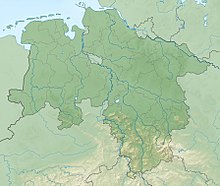Osenberg

The Osenberge are one to 23 m above sea level. NHN high dune landscape of the East Frisian-Oldenburg Geest . They are located near Oldenburg and Sandhatten in the Lower Saxony district of Oldenburg ( Germany ).
geography
location
The hill-like Osenberge are located in the northwest of the Wildeshauser Geest Nature Park, on average 14 km (as the crow flies ) south of Oldenburg , directly south of Bümmerstede and immediately northwest of Sandhatten . In the west they are passed in a south-north direction by a section of the Hunte , to the northwest lies Wardenburg .
The Osenberge are not mountains in the true sense of the word, as they rise only a few meters above the level of the western and eastern surroundings. But they are the highest peaks in the region, for example Oldenburg is only about 5 to 7 m high. Its two highest elevations, each 23 m high, are the Kistenberg south of Sandkrug and the Gierenberg northwest of Sandhatten; from the last named "mountain" you can enjoy the view of the valley of the Hunte. Within the forest and woodland area Barnführer Holz , the Osenberge are overgrown with old pine trees.
The Osenberge form a nearly closed forest belt, directly south of a from the southern border Oldenburg barracks with attached training area , south to spread Sandhatten. Only in the middle is the forest area divided into two parts by the locality Sandkrug , with the Osenberg mountains south of Sandkrug clearly dominating in terms of forest area and height. The northern area, near this barracks, is used by the Bundeswehr as a training area.
Natural allocation
The surveys form the natural area Osenberge (600.14) in the main natural unit group East Frisian-Oldenburg Geest (No. 60), in the main unit Hunte-Leda-Moorniederung (600) and in the subunit southern and eastern moor edge (600.1). The neighbors include in particular the natural area Astruper Huntetal (600.13) in the west, the natural area Huder and Oldenburger Moore (612.14) in the east, that in the main unit group Ems-Weser-Marsch (61) and in the main unit Wesermarschen (612) to the subunit jade -Weser-Becken (612.1) counts, and the subunit Dötlinger Huntetal (595.01) in the south, which belongs in the main unit group Ems-Hunte-Geest (59) to the main unit Delmenhorster Geest (595).
Protected areas
In the southeast of the Osenberge lies the Tannersand and Gierenberg nature reserve ( CDDA no. 82686; designated 1938; 29.6 hectares in size) with the Tannersand and Gierenberg fauna-flora-habitat area (FFH no. 2915-331; 29.65 Ha). The landscape protection area (LSG) Staatsforst Alt-Osenberge, Wunderhorn, Oldenburger Sand, Tannersand with peripheral areas (CDDA no. 324746; 1976; 8.876 km² ) is located in large parts of the southeast , and the LSG Neu-Osenberge (CDDA no . 323203; 1976; 80.8 ha).
history
The sandy landscape of the Osenberge was formed during the last ice age ( Weichsel ice age ). In the Middle Ages and in the early modern period, massive overexploitation of nature in the form of centuries-old hud economics and unregulated timber management led to the extensive obstruction of the Osenberge. The grazing of the areas by flocks of sheep prevented a new forest from developing. Plagging as part of the eternal cultivation of rye and the extraction of litter led to the formation of large areas of drift sand and the formation of meter-high shifting dunes on the very nutrient-poor soils . Towards the end of the 18th century, the massive formation of shifting dunes threatened agricultural land and settlements. From 1803 this led to a targeted cultivation of the resulting wasteland of the Osenberge, carried out by the Oldenburg state, the definition of the dunes and subsequent reforestation in the form of a pine monoculture. However, these subsequently proved to be very susceptible to wind breakage. On November 13, 1972, the Quimburga hurricane destroyed the holdings almost completely within a few hours. In the following years, however, there was renewed reforestation taking into account new findings in forestry.
From the world of legends it is known that a dwarf people are said to have lived in the Osenberge . The legend of the Oldenburger Wunderhorn also plays there .
traffic
First west past the Osenberge, then a little north of the center through them and then east past the elevations are the merging district roads 346 and 314, which run roughly in a north-west-south-east direction from Oldenburg through Sandkrug to Kirchhatten. The Kiebitzweg stop is located on the K 314 in Sandkrug and is served by the 315 city bus operated by Oldenburger Verkehr und Wasser GmbH .
literature
Peter Biel: Sand pitcher . Isensee, Oldenburg 1996, ISBN 3-89598-333-0 . , therein: The Osenberge, pages 11–109
Web links
Coordinates: 53 ° 1 ′ 34 ″ N , 8 ° 17 ′ 3 ″ E
Individual evidence
- ↑ a b Map services of the Federal Agency for Nature Conservation ( information )
-
^ Map of the Osenberge , on commons.wikimedia.org see also referenced map services of the Federal Agency for Nature Conservation
- ^ "Tannersand and Gierenberg" nature reserve at the Lower Saxony State Office for Water Management, Coastal Protection and Nature Conservation
- ↑ Eilert Tantzen : The reforestation of heaths and wastelands by the Oldenburg State Forest Administration in the 19th century. Oldenburg 2008. P. 97 ff
- ↑ Ludwig Strackerjahn and Karl Willoh (Editor 2nd Edition): superstition and legends from the Duchy Oldenburg . Oldenburg 1909

